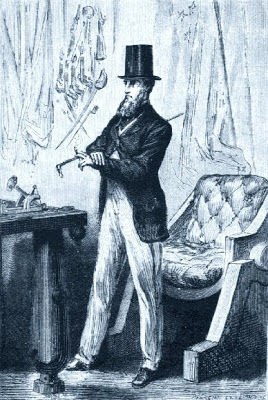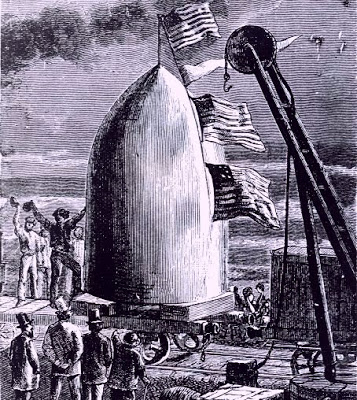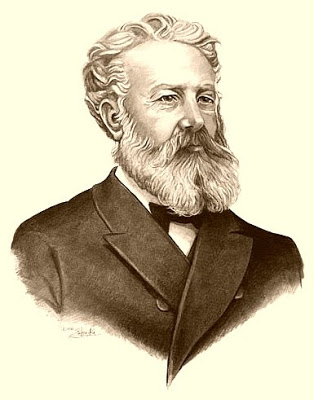Philosophy



Impey Barbicane? Yes, Impey Barbicane...the hero, who having determined that a projectile can be fired to the moon, moves to Florida and constructs the Columbiad cannon which fires a bullet-like spacecraft that successfully carries a crew of three to the moon and back in Jules Verne's From the Earth to the Moon [1865]. Today marks the passing of Jules Verne in 1905.
C. D. Merriman wrote...
Through his series of Les Voyages Extraordinaires and the fantastic and detailed illustrations which accompanied them, Verne predicted the use of hydrogen as an energy source (in From the Earth to the Moon) and many future modern conveniences and technological inventions such as skyscrapers, submarines, helicopters, and airplanes. The pioneering ways of travel and exploration which he wrote so much about are now common-place for us, such as exploration of the moon, the north and south poles, and the use of hot air balloons for long-distance voyages. In his time Verne was a true inventor and visionary; the names of his inventions and characters such as Captain Nemo, Phileas Fogg, and the submarine Nautilus have entered, and remain, a part of our popular culture. Verne's works have been translated from the French to numerous languages but unfortunately in the earlier English editions much of his scientific detail is lost; they are often abridged, sometimes censored. Because of this, there is much mis-perception about Verne, and claims of racism and anti-semitism. Scholars continue to study Verne's life and works to bring to light the authentic man and his extraordinary vision of the future.
Jules Gabriel Verne was born on 8 February 1828 in Nantes, Pays de la Loire, France, the first of five children born to Sophie Henriette Allotte de la Fuye (d. 1887) and Pierre Verne (1799-1871), attorney. In the busy maritime port city and summers spent on the Loire River, Verne was exposed to the comings and goings of schooners and ships that sparked his imagination for travel and adventure. After attending boarding school during which he started to write short stories and poetry, Verne settled in Paris to study law, as his father had done. However, upon obtaining his degree in 1850, he was much more interested in theatre, to his father's disappointment. Living a bohemian life, he wrote and collaborated on numerous plays, dramas, and operettas including Blind Man's Bluff (1852), often collaborating with his friend and musician Jean Louis Aristide Hignard (1822-1897).
In 1857 Verne married Honorine de Viane Morel (1830-1910), a widow with two daughters, Suzanne and Valentine, and with whom Jules would have one child, Michel Jean Verne (1861-1925). Michel's early years were troubled and he accumulated much debt, which his father later re-paid. While not working at the Stock Market, Jules and Honorine traveled much in America, France, and the British Isles during which Verne met fellow authors Alexandre Dumas and his son, and Victor Hugo. While his novels had previously been rejected by publishers, after making the acquaintance of editor and publisher Pierre Jules Hetzel (1814-1886) Verne's literary career was launched. In 1863 Five Weeks in a Balloon or, Journeys and Discoveries in Africa by Three Englishmen was published to wide acclaim, the first of his "extraordinary adventures" series. It was soon followed by Journey to the Center of the Earth (1864), From the Earth to the Moon (1865), and its sequel All Around the Moon (1870). Many of his novels were first serialised in Hetzel's Magazine d'Éducation et de Récréation.
When not living in Amiens, Picardie, France, Verne and his wife spent much time sailing on his ship the Saint-Michel. His own adventures sailing to myriad ports in the British Isles, Portugal, the Netherlands, and the Mediterranean provided much fodder for his short stories and novels. The Adventures of a Special Correspondent (1872) was followed by The Mysterious Island (1875), The Survivors of the Chancellor (1875), Michael Strogoff (1876), and Dick Sand: A Captain at Fifteen (1878). In 1867 he travelled to America.
In 1886 Verne's mentally ill nephew Gaston shot him, and thereafter he walked with a limp. In 1888 Verne was elected councillor of Amiens, a position he served faithfully for the next fifteen years. He also continued to travel and write and among his later publications are Eight Hundred Leagues on the Amazon (1881), Robur the Conqueror (1886), Ticket No. 9672 (1886), Facing the Flag (1896), and Master of the World (1904). After developing diabetes, Jules Verne died on 24 March 1905. He now rests in La Madeleine Cemetery in Amiens, Picardie, France, a massive marble statue of a man emerging from the earth reaching towards the sky adorning his grave. Michel oversaw the publication of numerous post-humous works of his father's including Paris in the Twentieth Century (written in the late 1850's, pub. 1994), The Lighthouse at the End of the World (1905), The Golden Volcano (1906), and The Hunt for the Meteor (1908).
North American Jules Verne Society, Inc.
107 years ago today Georges Melies took us to the moon
Verne...astronomy and astronomers
- Lost Book By Jules Verne..."paris In The Twentieth Century"
Steven Silvers... Before he wrote Twenty Thousand Leagues Under the Sea, Journey to the Center of the Earth or Around the World in Eighty Days, Jules Verne wrote a short novel about Michel Dufrenoy living in Paris in the Twentieth Century. This novel...
- Good Luck...just Way Too Many Issues To Address
"Space travel: Finding the technology to traverse the stars" The research-and-development arm of the U.S. military is launching a 100-Year Starship Study to find the technologies necessary for interstellar travel. by Amina Khan August 6th, 2011 Los...
- France's "mysterious Island"...endangered
Jules Verne wrote a book called Mysterious Island complete with strange creatures and the wet dock for Captain Nemo's Nautilus. Today a new island has been formed with less than monstrous creatures and being invaded by the human species. "France's...
- Lucian Of Samosata
Lucian of Samosata was an Assyrian rhetorician, and satirist who wrote in the Greek language. Le Vere Narrationi, A True History, parodied some fantastic tales told by Homer in the Odyssey. Lucian anticipated “modern” fictional themes like voyages...
- Classic Literature/science
FICTION Abbott, Edwin A. Flatland: A Romance of Many Dimensions LucianA True Story Verne, Jules Around the World in Eighty Days Verne, Jules Earth to the Moon Verne, Jules Five Weeks in a Balloon ...
Philosophy
Impey Barbicane and Jules Verne

Impey Barbicane

From the Earth to the Moon

Jules Verne
February 8th, 1828 to March 24th, 1905
Impey Barbicane? Yes, Impey Barbicane...the hero, who having determined that a projectile can be fired to the moon, moves to Florida and constructs the Columbiad cannon which fires a bullet-like spacecraft that successfully carries a crew of three to the moon and back in Jules Verne's From the Earth to the Moon [1865]. Today marks the passing of Jules Verne in 1905.
C. D. Merriman wrote...
Through his series of Les Voyages Extraordinaires and the fantastic and detailed illustrations which accompanied them, Verne predicted the use of hydrogen as an energy source (in From the Earth to the Moon) and many future modern conveniences and technological inventions such as skyscrapers, submarines, helicopters, and airplanes. The pioneering ways of travel and exploration which he wrote so much about are now common-place for us, such as exploration of the moon, the north and south poles, and the use of hot air balloons for long-distance voyages. In his time Verne was a true inventor and visionary; the names of his inventions and characters such as Captain Nemo, Phileas Fogg, and the submarine Nautilus have entered, and remain, a part of our popular culture. Verne's works have been translated from the French to numerous languages but unfortunately in the earlier English editions much of his scientific detail is lost; they are often abridged, sometimes censored. Because of this, there is much mis-perception about Verne, and claims of racism and anti-semitism. Scholars continue to study Verne's life and works to bring to light the authentic man and his extraordinary vision of the future.
Jules Gabriel Verne was born on 8 February 1828 in Nantes, Pays de la Loire, France, the first of five children born to Sophie Henriette Allotte de la Fuye (d. 1887) and Pierre Verne (1799-1871), attorney. In the busy maritime port city and summers spent on the Loire River, Verne was exposed to the comings and goings of schooners and ships that sparked his imagination for travel and adventure. After attending boarding school during which he started to write short stories and poetry, Verne settled in Paris to study law, as his father had done. However, upon obtaining his degree in 1850, he was much more interested in theatre, to his father's disappointment. Living a bohemian life, he wrote and collaborated on numerous plays, dramas, and operettas including Blind Man's Bluff (1852), often collaborating with his friend and musician Jean Louis Aristide Hignard (1822-1897).
In 1857 Verne married Honorine de Viane Morel (1830-1910), a widow with two daughters, Suzanne and Valentine, and with whom Jules would have one child, Michel Jean Verne (1861-1925). Michel's early years were troubled and he accumulated much debt, which his father later re-paid. While not working at the Stock Market, Jules and Honorine traveled much in America, France, and the British Isles during which Verne met fellow authors Alexandre Dumas and his son, and Victor Hugo. While his novels had previously been rejected by publishers, after making the acquaintance of editor and publisher Pierre Jules Hetzel (1814-1886) Verne's literary career was launched. In 1863 Five Weeks in a Balloon or, Journeys and Discoveries in Africa by Three Englishmen was published to wide acclaim, the first of his "extraordinary adventures" series. It was soon followed by Journey to the Center of the Earth (1864), From the Earth to the Moon (1865), and its sequel All Around the Moon (1870). Many of his novels were first serialised in Hetzel's Magazine d'Éducation et de Récréation.
When not living in Amiens, Picardie, France, Verne and his wife spent much time sailing on his ship the Saint-Michel. His own adventures sailing to myriad ports in the British Isles, Portugal, the Netherlands, and the Mediterranean provided much fodder for his short stories and novels. The Adventures of a Special Correspondent (1872) was followed by The Mysterious Island (1875), The Survivors of the Chancellor (1875), Michael Strogoff (1876), and Dick Sand: A Captain at Fifteen (1878). In 1867 he travelled to America.
In 1886 Verne's mentally ill nephew Gaston shot him, and thereafter he walked with a limp. In 1888 Verne was elected councillor of Amiens, a position he served faithfully for the next fifteen years. He also continued to travel and write and among his later publications are Eight Hundred Leagues on the Amazon (1881), Robur the Conqueror (1886), Ticket No. 9672 (1886), Facing the Flag (1896), and Master of the World (1904). After developing diabetes, Jules Verne died on 24 March 1905. He now rests in La Madeleine Cemetery in Amiens, Picardie, France, a massive marble statue of a man emerging from the earth reaching towards the sky adorning his grave. Michel oversaw the publication of numerous post-humous works of his father's including Paris in the Twentieth Century (written in the late 1850's, pub. 1994), The Lighthouse at the End of the World (1905), The Golden Volcano (1906), and The Hunt for the Meteor (1908).
North American Jules Verne Society, Inc.
107 years ago today Georges Melies took us to the moon
Verne...astronomy and astronomers
- Lost Book By Jules Verne..."paris In The Twentieth Century"
Steven Silvers... Before he wrote Twenty Thousand Leagues Under the Sea, Journey to the Center of the Earth or Around the World in Eighty Days, Jules Verne wrote a short novel about Michel Dufrenoy living in Paris in the Twentieth Century. This novel...
- Good Luck...just Way Too Many Issues To Address
"Space travel: Finding the technology to traverse the stars" The research-and-development arm of the U.S. military is launching a 100-Year Starship Study to find the technologies necessary for interstellar travel. by Amina Khan August 6th, 2011 Los...
- France's "mysterious Island"...endangered
Jules Verne wrote a book called Mysterious Island complete with strange creatures and the wet dock for Captain Nemo's Nautilus. Today a new island has been formed with less than monstrous creatures and being invaded by the human species. "France's...
- Lucian Of Samosata
Lucian of Samosata was an Assyrian rhetorician, and satirist who wrote in the Greek language. Le Vere Narrationi, A True History, parodied some fantastic tales told by Homer in the Odyssey. Lucian anticipated “modern” fictional themes like voyages...
- Classic Literature/science
FICTION Abbott, Edwin A. Flatland: A Romance of Many Dimensions LucianA True Story Verne, Jules Around the World in Eighty Days Verne, Jules Earth to the Moon Verne, Jules Five Weeks in a Balloon ...
